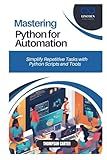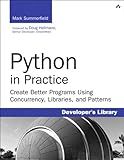Best Python Multiprocessing Tools to Buy in December 2025

MASTERING PYTHON FOR AUTOMATION: Simplify Repetitive Tasks with Python Scripts and Tools



Python 3 Standard Library by Example, The (Developer's Library)



Python in Practice: Create Better Programs Using Concurrency, Libraries, and Patterns (Developer's Library)



Machine Learning with R, the tidyverse, and mlr


Multiprocessing is a Python module that allows you to parallelize the execution of your code across multiple processors or CPU cores. It provides an efficient way to make your programs run faster by utilizing the available hardware resources.
To use multiprocessing in Python, you need to follow these steps:
- Import the necessary modules:
import multiprocessing
- Define the function that will be executed in parallel. This function should be independent and take input arguments (if any). It will be called by the worker processes.
def my_function(arg): # Code to be executed in parallel ...
- Create a Pool object that will manage the worker processes. The Pool object allows you to specify the number of worker processes to be created.
pool = multiprocessing.Pool(processes=4) # Create a pool with 4 worker processes
- Use the map() method of the Pool object to apply the function in parallel to a list of input arguments. This method splits the input list into chunks and assigns each chunk to a worker process, which executes the function on the individual elements and returns the results.
input_list = [...] # List of input arguments results = pool.map(my_function, input_list) # Apply the function to the list in parallel
- You can also use the apply_async() method of the Pool object to schedule individual tasks asynchronously. This method returns a AsyncResult object that you can use to get the result of the computation later on.
result = pool.apply_async(my_function, (arg_1, arg_2)) # Schedule the task and get a result object ... result.get() # Get the result of the computation (blocking call)
- Remember to call the close() and join() methods of the Pool object to properly manage the worker processes. The close() method prevents any more tasks from being submitted to the pool, while the join() method waits for all the worker processes to complete.
pool.close() # Prevent any more tasks from being submitted pool.join() # Wait for all worker processes to complete
By utilizing multiprocessing, you can distribute the workload across multiple CPU cores, making your code execute faster and taking full advantage of your hardware resources.
What are the best practices for using multiprocessing in Python?
Here are some best practices for using multiprocessing in Python:
- Avoid the Global Interpreter Lock (GIL): The GIL in Python prevents true parallel execution of threads. To overcome this limitation, use the multiprocessing module, which offers a process-based approach with separate Python interpreter instances.
- Understand the difference between threads and processes: Multiprocessing deals with processes, not threads. Each process has its own memory space, whereas threads within a process share the same memory. Consider the use case and choose between threads (with threading module) or processes (with multiprocessing module) accordingly.
- Use multiprocessing.Pool for task distribution: The multiprocessing.Pool class provides an easy way to distribute work across multiple processes. It automatically manages the creation and management of a pool of worker processes, allowing you to parallelize tasks easily.
- Be aware of inter-process communication (IPC) overhead: Communication between processes involves some overhead due to data serialization, inter-process communication, and synchronization mechanisms. Minimize the amount of data passed between processes and avoid unnecessary synchronization.
- Prevent shared data problems: If multiple processes try to modify shared data simultaneously, race conditions and other synchronization issues may arise. Use synchronization primitives like locks, semaphores, and queues to protect shared data and ensure atomicity.
- Utilize shared memory when needed: The multiprocessing module provides shared memory objects (e.g., Array and Value) to share data between processes more efficiently. These objects have built-in synchronization mechanisms to avoid data corruption.
- Make child processes independent and self-contained: Each process should perform a specific task independently, without relying on the parent process or other child processes. This approach improves code reusability, modularity, and maintainability.
- Pay attention to process termination: Ensure that child processes are properly terminated when they finish their work. Neglecting to terminate processes may leave them running indefinitely, consuming unnecessary system resources.
- Handle exceptions and errors gracefully: Errors and exceptions may occur during multiprocessing. Implement proper error handling and exception management to avoid crashing the entire program and provide useful feedback to the user.
- Profile and benchmark: Measure the performance of your multiprocessing code using profiling and benchmarking tools. This helps identify bottlenecks, optimize resource usage, and tune the number of worker processes.
Remember, multiprocessing is not always the best solution. Before parallelizing code, assess whether parallel execution will truly improve performance. Consider profiling and optimizing the serial implementation first, as well as exploring other alternatives like asynchronous programming or distributed computing frameworks.
How to limit the number of concurrently running processes in Python multiprocessing?
To limit the number of concurrently running processes in Python's multiprocessing module, you can make use of a Semaphore object from the threading module. Here is an example:
import multiprocessing import time import threading
def worker(): # Simulating some time-consuming task time.sleep(1) print("Task completed")
def main(): # Maximum number of concurrent processes max_concurrent_processes = 3
# Create a Semaphore with the desired maximum number of concurrent processes
semaphore = threading.Semaphore(max\_concurrent\_processes)
# List to store the running processes
processes = \[\]
for \_ in range(10): # Number of tasks to run
semaphore.acquire() # Acquire a semaphore slot before starting a process
# Create a process
process = multiprocessing.Process(target=worker)
process.start()
processes.append(process)
for process in processes:
process.join()
semaphore.release() # Release a semaphore slot after a process completes
if __name__ == '__main__': main()
In this example, we set the max_concurrent_processes variable to 3, meaning that only three processes will be allowed to run concurrently. We create a Semaphore object with this value. For each task to run, we first acquire a semaphore slot using the semaphore.acquire() method. This blocks the execution if all slots are acquired and waits until a slot is released. After acquiring a slot, we create a multiprocessing Process and start it. Finally, when a process completes, we call semaphore.release() to release a slot, allowing another process to start.
How to implement a shared counter using multiprocessing in Python?
To implement a shared counter using multiprocessing in Python, you can use the Value object from the multiprocessing module. Here's an example:
import multiprocessing
def process_counter(counter): # Increment the counter by 1 with counter.get_lock(): counter.value += 1
if __name__ == '__main__': # Initialize the shared counter with a value of 0 counter = multiprocessing.Value('i', 0)
# Create multiple processes
processes = \[\]
for \_ in range(10):
p = multiprocessing.Process(target=process\_counter, args=(counter,))
processes.append(p)
p.start()
# Wait for all processes to finish
for p in processes:
p.join()
# Print the final counter value
print(counter.value)
In this example, the counter variable is initialized as a shared Value object with an initial value of 0. It is then passed as an argument to the target function process_counter which increments the counter value by 1. The with counter.get_lock() block ensures that only one process can access the counter at a time, avoiding race conditions. Finally, the counter.value is printed to show the final value of the counter after all processes have finished.
